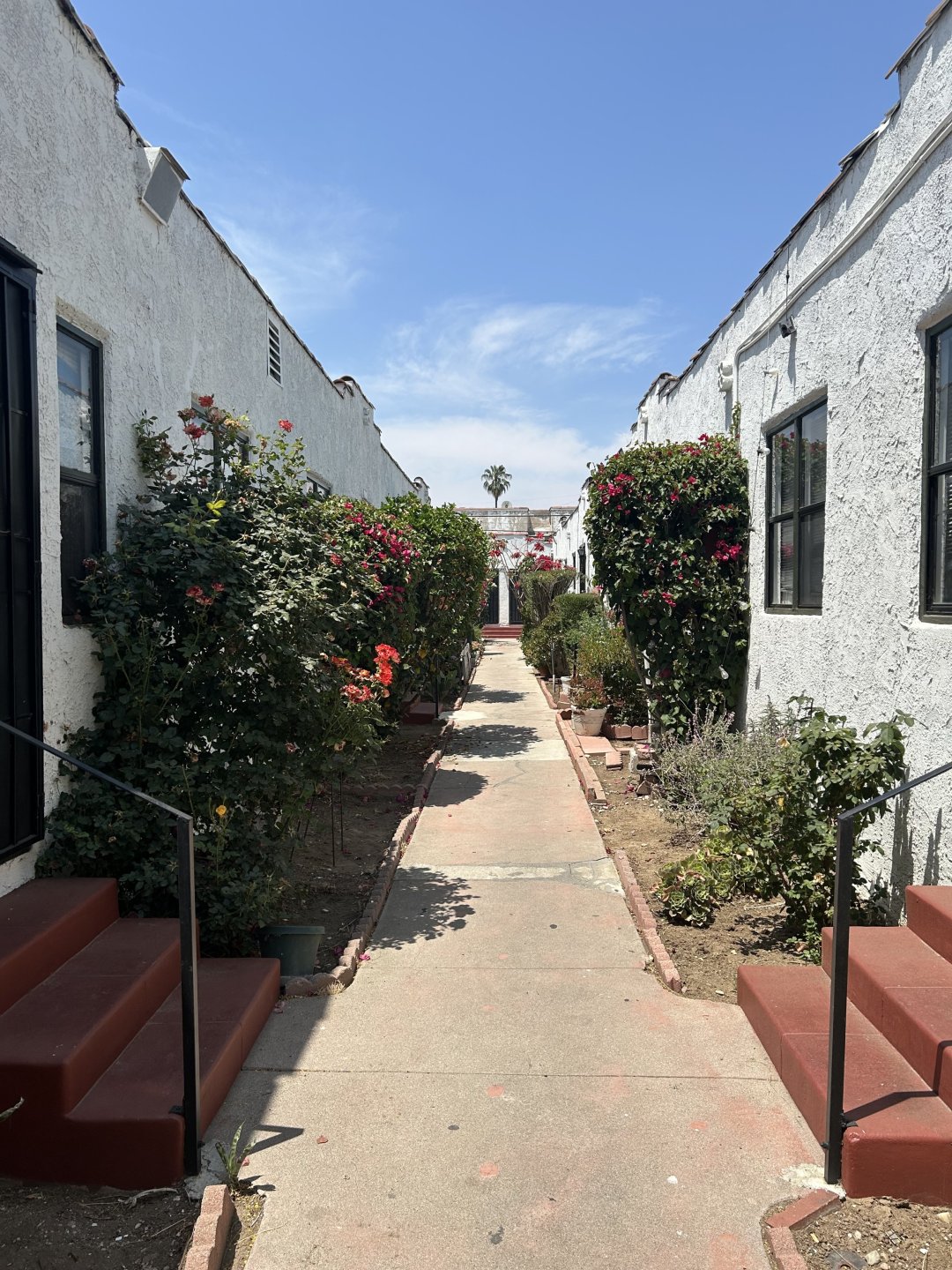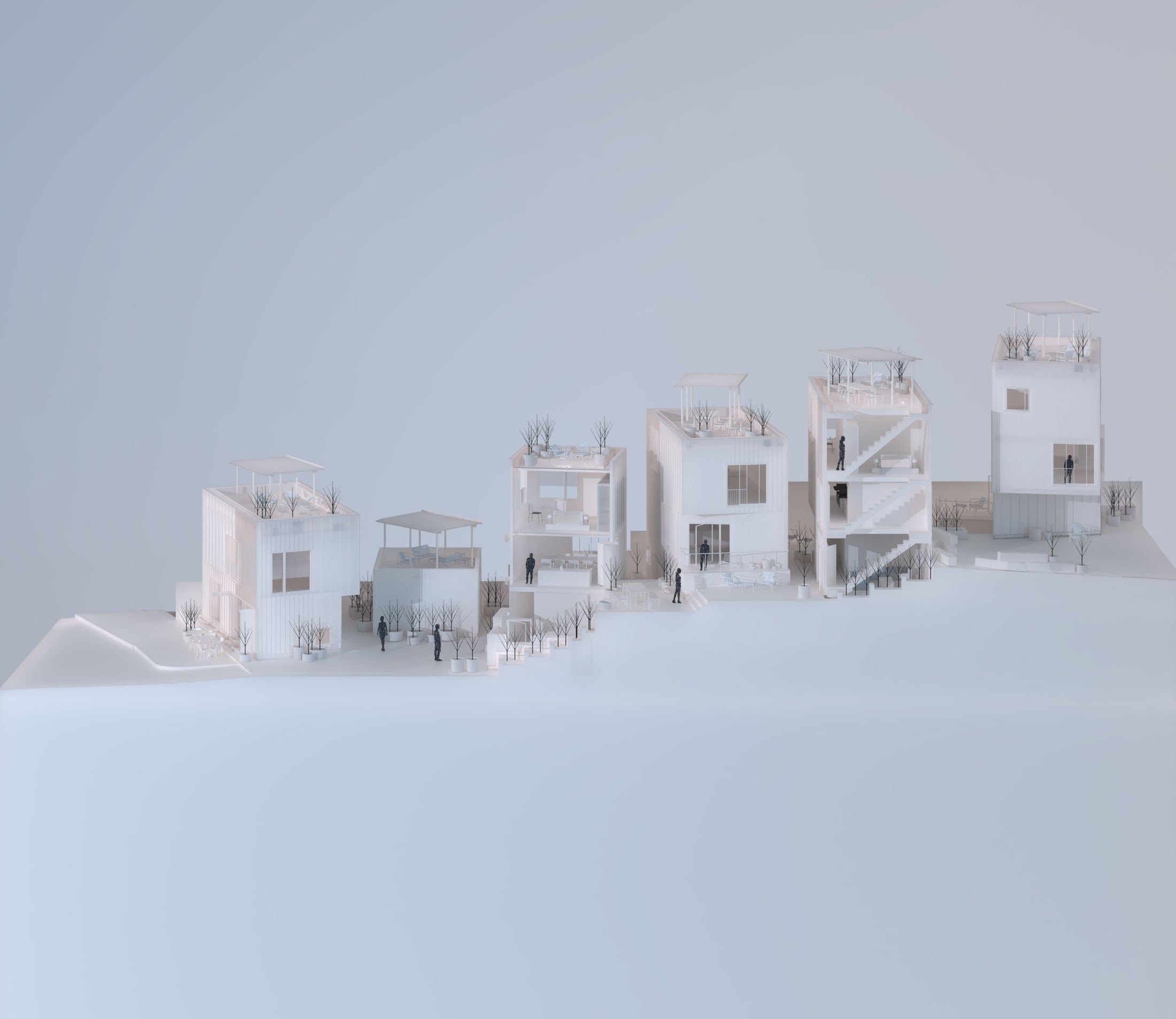
Despite its poor upkeep, outdated appliances, and an exposed water heater that took up half the kitchen floor area, my former East Hollywood rental was a charmer. Designed in the Mission Revival style in 1923, it was one of the street-facing units of a typical bungalow court: Two rows of tightly-packed modules face one another to pack 12 single-story homes within less than a quarter of an acre, leaving just enough room for a decorated walking path along its center and secondary paths along its perimeter, for trash removal. My neighbors and I kept our windows open to let in the songs of birds that nested in the trees of our tiny front yards. Thanks to the several other bungalow courts that are still standing, East Hollywood remains one of the few walkable neighborhoods in a city of far too few.
Coming in many shapes and styles, and often built inexpensively, quickly, and durably, bungalow courts cleverly combine some of the benefits of single-family home design—direct access to the outdoors, a front yard, a backyard, and natural lighting from multiple sides—with the affordability and space efficiency of apartment buildings.
They originated in the early 1900s, when the working class migrated to Los Angeles in droves to avoid the unsanitary living conditions of East Coast tenement apartments. (Parking was of little concern; they didn’t have much use for the automobile, relying instead on what was, by the 1920s, the most extensive streetcar network in the United States for transportation.) Housing developers, in turn, helped shape Los Angeles into a global economic center that didn’t look or feel like one through the invention of low-rise, medium-density housing types uniquely suited to Southern California’s sunny-year-round climate.
As the city’s population reached one million by 1924, young and intrepid Modernist architects—including Irving Gill, Richard Neutra, and John Lautner—worked with developers to invent multifamily housing solutions of their own. Walk along Griffith Park Boulevard in Silver Lake, for instance, and you’ll find the Bubeshko Apartments, the Austrian émigré Rudolph Schindler’s ivory white vision of a Greek hillside of homes for the modern city, adorned with abstracted ram’s-head sculptures and little else. In the 1930s, Anastasia Bubeshko and her daughter Luby commissioned Schindler to build a home on a steep site with five units, partially stacked atop one another, that could be reconfigured into seven to provide additional rental income. The central stairway and the geometric rooflines follow the slope to offer each of its residents private access to the outdoors within a remarkably tight footprint.
Farther north, Garrett Eckbo and Gregory Ain’s Avenel Cooperative demonstrates a passion for social housing that was later used as evidence for Ain’s Communist sympathies during the McCarthy era. Ain worked around restrictive codes to get the necessary funding from the Federal Housing Administration, which had normally been reserved for the development of single-family housing. The five-car garage facing the street conceals 10 units of 960-square-foot homes, divided along two rows that zigzag to offer its residents nearly as much outdoor landscaping as interior space.
“We could have carried on building this type of housing were it not for the growing popularity of the car, and the growing perception among developers and property owners that on-site parking spaces were becoming essential,” says Frances Anderton, a local author whose 2022 book, Common Ground: Multifamily Housing in Los Angeles, highlights the city’s dwellings that are centered on shared open space. Like many things that made the Los Angeles of yesteryear a bastion of applied innovation, low-rise, medium-density housing was eventually regulated out of the market by greed and a desire for convenience.
The result is a 21st-century Los Angeles with a noticeable affordable housing crisis despite a wealth of historical precedents for alleviation. While single-family homes are still being developed unabated, the passing of the California HOME Act (SB 9) in 2021, which created a legal process for the construction of accessible dwelling units, or ADUs, in certain homeowners’ backyards, has primarily led to the increase in overall square footage of preexisting single-family properties among those who can afford their construction. Meanwhile, many affordable-housing proposals—such as Eric Owen Moss’s daring design for an underused lot in Venice—are hastily struck down by local homeowners wary of anything that may jeopardize skyrocketing property values.
Several recent events have fueled the collective imagination that still begs for redirection. The Palisades and Eaton fires that together destroyed more than 16,000 structures earlier this year have persuaded the local community and politicians alike to rebuild as quickly and as humanly possible. Ongoing development of more than 100 miles of railway in Los Angeles since the 1990s further reflects the local demand for higher-density, pedestrian-centered housing. All the while, the “missing middle”—a housing deficit currently plaguing many cities across the country—is perhaps most apparent in the Southland.
If we can instead imagine a California of the near future no longer bogged down by overly restrictive codes (it’s not easy, but worth a try), can we also imagine a Los Angeles in which bungalow courts and similar housing types are revived in great enough numbers to meet contemporary living standards? Can we imagine this housing being built quickly, under updated labor conditions, building material standards, and methods of construction?

Many active practitioners, thankfully, are now thinking along such lines. The nonprofit affordable housing developer RNLA (Restore Neighborhoods Los Angeles), for example, designed a bungalow court for formerly unhoused people, named Bungalow Gardens, in South Los Angeles, all eight units of which are fully wheelchair accessible (which certainly cannot be said of the century-old bungalow courts that stand on either side of it).
Meanwhile, the local architecture firm West of West will soon break ground on Echo Park Co-Living, a hillside housing development in which the bungalow court’s central walkway is modified into a “slow stair street” that weaves five buildings together across a sloping site. It recalls many of the bungalow courts of more than a century ago, which confidently climbed the hillside to form a complex yet deferential relationship with their surroundings.
And, perhaps most indicative of a broad cultural shift, the City of Los Angeles—in collaboration with cityLAB-UCLA and LA4LA—recently launched Small Lots, Big Impacts, a competition seeking design submissions for housing schemes adapted to the 24,000 vacant lots across the city. “Angelenos should be able to buy their first home and raise their families in our city,” Mayor Karen Bass stated in an initial press release. “We need to be embracing new and innovative construction methods and materials throughout the city.”
Final submissions presented more than 350 variations of low-rise, medium-density housing on plots of land as small as an eighth of an acre in proximity to mass transit stations. Some, such as Studio Even Odd’s winning entry, Little Sister, align with the city’s historically diverse definition of household by proposing flexible units that tap in to “L.A.’s culture of informal commerce and placemaking.” Others, such as Atelier Blumm, more specifically draw from the city’s colorful architectural past for inspiration while incorporating more contemporary concerns. “Our housing supply today faces similar issues to those which initially gave rise to the Arts & Crafts Movement,” its co-founders write of their Bungalow Flats proposal, which would apply noncombustible finishes along with conventional building techniques.
What nearly all the projects share in common is a blurring of interior and exterior, embracing the region’s Mediterranean climate that drew people here in droves at the turn of the 20th century. “There are really interesting creative ideas out there that are trying to meet Angelenos where they’re at,” says Anderton, the local author. “They’re not Chicagoans yet. They’re not New Yorkers yet. They’re still Angelenos.”